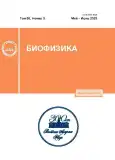The effect of acute phase proteins on the activity of peripheral blood neutrophils
- Authors: Fedorova N.D1, Sumbatian D.A1, Sokolov A.V2, Filatov M.V1, Trashkov A.P1, Varfolomeeva E.Y.1
-
Affiliations:
- Petersburg Nuclear Physics Institute named by B.P. Konstantinov of National Research Centre �Kurchatov Institute�
- Institute of Experimental Medicine
- Issue: Vol 68, No 3 (2023)
- Pages: 522-528
- Section: Articles
- URL: https://journals.rcsi.science/0006-3029/article/view/144454
- DOI: https://doi.org/10.31857/S0006302923030146
- EDN: https://elibrary.ru/FRZBBU
- ID: 144454
Cite item
Full Text
Abstract
About the authors
N. D Fedorova
Petersburg Nuclear Physics Institute named by B.P. Konstantinov of National Research Centre �Kurchatov Institute�
Email: fedorova_nd@pnpi.nrcki.ru
Gatchina, Leningrad Region, Russia
D. A Sumbatian
Petersburg Nuclear Physics Institute named by B.P. Konstantinov of National Research Centre �Kurchatov Institute�Gatchina, Leningrad Region, Russia
A. V Sokolov
Institute of Experimental MedicineSt. Petersburg, Russia
M. V Filatov
Petersburg Nuclear Physics Institute named by B.P. Konstantinov of National Research Centre �Kurchatov Institute�Gatchina, Leningrad Region, Russia
A. P Trashkov
Petersburg Nuclear Physics Institute named by B.P. Konstantinov of National Research Centre �Kurchatov Institute�Gatchina, Leningrad Region, Russia
E. Yu Varfolomeeva
Petersburg Nuclear Physics Institute named by B.P. Konstantinov of National Research Centre �Kurchatov Institute�Gatchina, Leningrad Region, Russia
References
- S. H. Kaufmann, Nat. Immunol., 9, 705 (2008).
- N. Borregaard, et al., Trends Immunol., 28, 340 (2007).
- P. Nordenfelt and H. Tapper, J. Leukoc. Biol., 90, 271 (2011).
- T. L. Leto and M. Geiszt, Antioxid. Redox Signal., 8, 1549 (2006).
- O. Soehnlein, J. Mol. Med., 87, 1157 (2009).
- M. Klemke, G. H. Wabnitz, F. Funke, et al., Immunity, 29, 404 (2008).
- B. D. Hock, K. G. Taylor, N. B. Cross, Immunology, 137, 249 (2012).
- El-Benna, et al., Immunol. Rev., 273, 180 (2016).
- Berton, et al., lnt. J. Clin. Lab. Res., 26, 160 (1996).
- M. R. White, E. Crouch, J. Vesona, Am. J. Physiol. Lung Cell. Mol. Physiol., 289, L606 (2005).
- G. Thomas and B. Rogues, FEBS Lett., 26, 169 (1972).
- K. L. Hartshorn, K. Sastry, D. Brown, et al. J. Immunol., 151, 1 (1993).
- E. Y. Varfolomeeva, E. V. Semenova, A. V. Sokolov, et al., Free Radic. Res., 50, 909 (2016).
- Н. Д. Федорова, Д. А. Сумбатян, М. А. Стукова и др., Актуальные вопросы биологич. физики и химии, 6 (1), 115 (2021).
- M. Filatov, E. Varfolomeeva, and E. Ivanov, Biochem. Mol. Med., 55, 116 (1995).
- E. Yu. Varfolomeeva, E. I. Ivanov, E. A. Drobchenko, et al., Bull. Exp. Biol. Med., 149, 485 (2010).
- A. V. Sokolov, L. Acquasaliente, V. A. Kostevich, et al., Free Radic. Biol. Med., 86, 279 (2015).
- B. J. Davis, Ann. N. Y. Acad. Sci. 121, 404 (1964).
- G. Berton, et al., Int. J. Clin. Lab. Res., 26, 160 (1996).
- K. Prasad, J. Cardiovasc. Pharmacol. Ther., 9 (3), 203 (2004). doi: 10.1177/107424840400900308
- L. Björkman, J. Karlsson, A. Karlsson, et al., J. Leukoc. Biol., 83 (2), 245 (2008). doi: 10.1189/jlb.0607-408. Epub 2007 Nov 5. PMID: 17984291
- M. J. Costello, H. Gewurz, J. N. Siegel, Clin. Exp. Immunol., 55 (2), 465 (1984).
- E. Hatanaka, F. P. Ribeiro, and A. Campa, FEMS Immunol. Med. Microbiol., 38 (1), 81 (2003). doi: 10.1016/S0928-8244(03)00112-3
- M. Blanter, et al., Front. Immunol., 13, Art. ID 820058 (2022). doi: 10.3389/fimmu.2022.820058
- Li, et al., Cell Commun. Signal., 17, 147 (2019).
- D. Wendisch, O. Dietrich, T. Mari, et al., Cell, 184 (26), 6243.e27(2021).
- S. Jaillon, A. Ponzetta, D. Di Mitri, et al., Nat. Rev. Cancer, 20, 485 (2020).
- E. J. H. van Houtum, C. Büll, L. A. M. Cornelissen, et al., Front. Immunol., 12, 790317 (2021).
- D. F. Quail, B. Amulic, M. Aziz, et al., J. Exp. Med., 219 (6), e20220011 (2022).
- S. Kamath and G. Y. Lip, QJM: Int. J. Med., 96 (10), 711 (2003). doi: 10.1093/qjmed/hcg129
- H. S. Goodridge, A. J. Wolf, and D. M. Underhill, Immunol. Rev., 230 (1), 38 (2009). doi: 10.1111/j.1600-065X.2009.00793.x
Supplementary files










